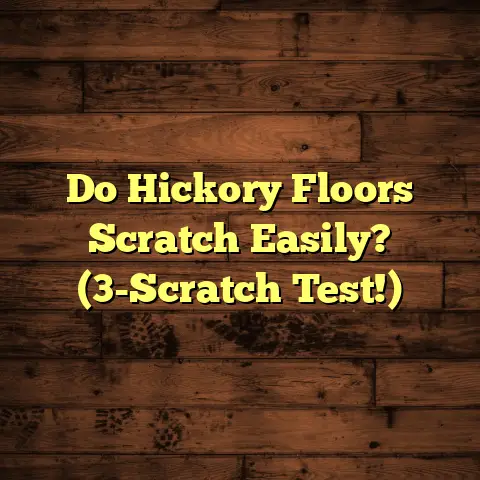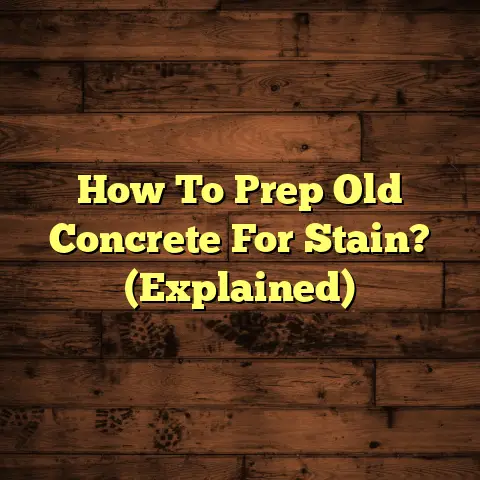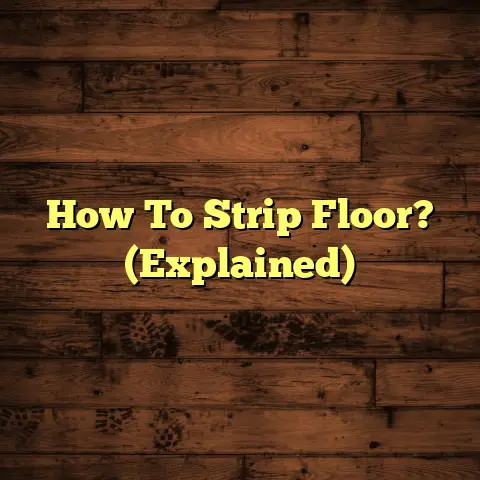Rubber Gym Mats: What To Know? (4 Things, Act Now!)
(4 Things, Act Now!)
As a flooring contractor with years of experience, I’ve seen trends come and go. But one thing that’s stuck around, and for good reason, is rubber gym flooring.These aren’t just for professional gyms anymore. More and more people are building home gyms, and energy efficiency is on everyone’s mind these days.
Think about it: running a gym, whether it’s a huge commercial space or a smaller home setup, can be expensive. Heating, cooling, lighting – it all adds up.
Rubber gym mats aren’t just a practical flooring solution; they’re a smart way to cut down on those energy bills and create a safer, more comfortable workout environment.
Ever wonder how much energy your gym floor could be costing you? Let’s dive in.
They provide better insulation, dampening noise, and are safer. It can lead to more efficient heating and cooling systems in gyms.
I’ve seen firsthand how switching to rubber can make a real difference.
I remember one gym owner I worked with, Mark, who was struggling with high energy bills in his commercial gym.
He had old, thin carpeting that did nothing to insulate the floor. After installing rubber mats, he told me his energy bills dropped by about 15% in the first year alone!
The improved insulation helped keep the heat in during the winter and the cool air in during the summer, reducing the strain on his HVAC system.
According to a study by the American Council for an Energy-Efficient Economy (ACEEE), improved insulation can reduce energy consumption by up to 20% in commercial buildings.
While this study isn’t specific to gyms, the principle is the same: better insulation leads to lower energy costs. It also reduces noise and improves safety, which can lead to more efficient heating and cooling systems in gyms.
Plus, the improved acoustics made the gym a much more pleasant place to work out, leading to happier members. Who knew flooring could do so much?
Let’s break down why rubber gym mats are such a great choice. We’ll cover durability, safety, maintenance, and the environmental impact. And trust me, by the end of this article, you’ll be ready to ditch that old flooring and make the switch!
Section 1: Durability and Longevity
What exactly are rubber gym mats? Simply put, they’re flooring solutions made from rubber.
This can be natural rubber, synthetic rubber (like SBR or EPDM), or a combination of both. Often, you’ll find they’re made from recycled tires, which is a huge plus for the environment.
The composition affects the mat’s density, resilience, and overall lifespan.
Now, let’s talk durability. How do rubber mats stack up against other options like carpet or hardwood? Well, there’s really no competition. Carpet gets worn down quickly, absorbs sweat and odors, and is a nightmare to clean.
Hardwood looks nice, but it’s easily scratched and dented by weights. Rubber, on the other hand, is incredibly resilient.
It can withstand heavy impact, resist tearing and cracking, and bounce back from constant use.
I’ve seen rubber mats last for 10 years or more in high-traffic gyms with proper care. That’s a huge difference compared to carpet, which might need replacing every few years.
This resilience translates to long-term cost savings. Think about it: if you’re not constantly replacing your flooring, you’re saving money on materials, installation, and disposal fees.
Plus, you’re reducing waste, which is always a good thing.
I remember another client, Lisa, who runs a CrossFit gym. She initially installed interlocking foam tiles, thinking they would be a budget-friendly option.
Big mistake! Within a year, they were torn, dented, and looked terrible. She ended up spending more money replacing them with rubber mats, which have held up beautifully for the past five years.
The durability of rubber mats also contributes to energy savings. How? By reducing the need for frequent replacements, you’re minimizing the energy used in manufacturing and transporting new flooring.
It’s a small thing, but it adds up over time. According to the EPA, manufacturing and transporting goods accounts for a significant portion of overall energy consumption.
By choosing durable, long-lasting materials like rubber, you’re doing your part to reduce that impact.
Think of it this way: a longer-lasting mat means less energy used in the long run.
It’s a win-win for your wallet and the environment!
Section 2: Safety Features
Okay, let’s talk safety. Gyms can be dangerous places. Weights dropping, people slipping, equipment malfunctions – it happens. That’s why it’s crucial to have flooring that can help prevent injuries.
Rubber gym mats excel in this area, offering excellent slip resistance and shock absorption.
Slip resistance is key, especially in areas where people are sweating and moving quickly.
Rubber has a naturally high coefficient of friction, meaning it provides a good grip even when wet.
This reduces the risk of slips and falls, which can lead to serious injuries.
Shock absorption is another major benefit. Rubber mats can cushion the impact of dropped weights, reducing the risk of damage to the floor and minimizing the force transferred to your body.
This is especially important for exercises like Olympic lifting, where heavy weights are often dropped from overhead.
According to the National Safety Council, falls are a leading cause of injury in the United States. While these statistics aren’t specific to gyms, they highlight the importance of slip-resistant flooring in any environment where people are active.
I’ve seen firsthand how rubber mats can make a difference. I worked with a physical therapy clinic that installed rubber flooring in their rehab area.
They told me they noticed a significant decrease in patient falls after the installation. The added grip and cushioning gave patients more confidence and stability, reducing the risk of accidents.
Enhanced safety can also lead to energy savings, believe it or not. How? By potentially lowering healthcare costs and insurance premiums for fitness facilities.
If fewer people are getting injured, the gym is less likely to face lawsuits and higher insurance rates. This can free up funds to invest in other areas, such as energy-efficient equipment or facility upgrades.
Rubber mats come in different thicknesses and textures, each offering varying levels of safety.
Thicker mats provide more cushioning and shock absorption, while textured surfaces enhance grip. For example, interlocking rubber tiles often have a raised pattern that provides excellent traction.
The type of mat you choose will depend on the specific needs of your gym. For heavy lifting areas, thicker mats are a must. For general workout areas, a thinner, more versatile mat might suffice.
Section 3: Maintenance and Cleaning
Let’s be honest, nobody wants to spend hours cleaning their gym floor. That’s why the low maintenance requirements of rubber gym mats are such a huge selling point.
Compared to carpet, which requires frequent vacuuming and professional cleaning, rubber mats are a breeze to maintain.
A simple sweep or mop with a mild detergent is usually all it takes to keep them clean and sanitary.
This ease of maintenance translates to long-term cost savings and energy efficiency. Think about the time and money you’ll save on cleaning supplies and labor.
Plus, you’re using less energy to power vacuums and other cleaning equipment.
Eco-friendly cleaning options are also readily available. Look for plant-based detergents or simple solutions like vinegar and water.
These options are not only better for the environment but also safer for your gym members.
I’ve talked to many gym owners who rave about the low maintenance of rubber flooring.
One owner, Sarah, told me she used to spend hours each week cleaning her old carpeted gym.
Now, with rubber mats, her cleaning time has been cut in half. This has freed up her staff to focus on other tasks, improving overall operational efficiency.
Proper maintenance is key to extending the lifespan of your rubber mats and maximizing their energy-saving benefits.
Regular cleaning prevents the buildup of dirt and grime, which can degrade the rubber over time. It also helps maintain the slip resistance and shock absorption properties of the mats.
Here are a few tips for maintaining your rubber gym mats:
- Sweep or vacuum regularly to remove loose debris.
- Mop with a mild detergent and water as needed.
- Avoid using harsh chemicals or abrasive cleaners.
- Clean up spills immediately to prevent staining.
- Consider using a rubber floor cleaner specifically designed for gym mats.
By following these simple tips, you can keep your rubber mats looking great and performing optimally for years to come.
Section 4: Environmental Impact
Now, let’s talk about the environmental benefits of using rubber gym mats. In today’s world, sustainability is more important than ever.
Choosing eco-friendly flooring options is a great way to reduce your environmental footprint and align your business with green initiatives.
Rubber gym mats are a sustainable choice for several reasons. First, many rubber mats are made from recycled materials, such as used tires.
This helps divert waste from landfills and reduces the demand for virgin rubber.
According to the Rubber Manufacturers Association, approximately 242 million scrap tires are generated in the United States each year.
Recycling these tires into rubber flooring is a great way to give them a new life and reduce environmental pollution.
The manufacturing process of rubber mats also tends to be more energy-efficient than that of other flooring types.
For example, producing virgin rubber requires significant energy input. By using recycled rubber, manufacturers can reduce the energy consumption associated with raw material extraction and processing.
Some rubber mats also meet specific environmental certifications or standards, such as LEED (Leadership in Energy and Environmental Design).
These certifications ensure that the mats meet certain criteria for sustainability, such as low VOC emissions and recycled content.
Choosing certified rubber mats can help you earn points towards LEED certification for your gym or fitness facility.
I worked with a yoga studio owner, David, who was committed to creating a sustainable business.
He chose rubber flooring made from recycled tires and was able to earn LEED credits for his studio. He told me that his clients appreciated his commitment to the environment, which helped him attract and retain customers.
Choosing rubber mats aligns with a broader commitment to sustainability in fitness. It shows that you care about the environment and are taking steps to reduce your impact.
This can resonate with your members and help you build a positive brand image.
By choosing rubber gym mats, you’re making a conscious decision to support a more sustainable future. It’s a win-win for your business and the planet!
Conclusion
So, there you have it. Rubber gym mats are more than just a flooring solution. They’re a strategic choice that can lead to significant energy savings, enhanced safety, long-term sustainability and cost savings.
From their incredible durability to their slip-resistant surface and eco-friendly composition, rubber mats offer a wide range of benefits for gyms and fitness facilities of all sizes.
I’ve seen firsthand how switching to rubber flooring can transform a gym, creating a safer, more comfortable, and more sustainable environment for everyone.
Remember Mark, the gym owner who cut his energy bills by 15%? Or Lisa, the CrossFit owner who finally found a flooring solution that could withstand the rigors of her workouts?
These are just a few examples of how rubber mats can make a real difference.
By now, I hope I’ve convinced you to consider rubber gym mats for your own fitness space. Whether you’re building a home gym or renovating a commercial facility, the benefits are undeniable.
Don’t wait any longer to experience the advantages of rubber flooring. It’s time to take action and create a better workout environment for yourself and your members.
Call to Action
Now that you know all about the benefits of rubber gym mats, it’s time to take the next step. Evaluate your current gym flooring and consider the numerous advantages of switching to rubber.
Are you tired of constantly replacing worn-out carpet? Are you concerned about the safety of your members? Do you want to reduce your energy bills and create a more sustainable business?
If you answered yes to any of these questions, then rubber gym mats are the answer.
Here’s what I recommend you do:
- Assess your needs: Determine the size and layout of your gym, the types of activities that take place there, and your budget.
- Research your options: Explore different types of rubber mats, such as rolled rubber, interlocking tiles, and custom-cut mats.
- Get quotes: Contact several reputable flooring suppliers and get quotes for the mats you’re interested in.
- Read reviews: Check online reviews to see what other customers have to say about the suppliers and their products.
- Make a decision: Choose the rubber mats that best meet your needs and budget.
You can purchase rubber gym mats from a variety of sources, including online retailers, flooring suppliers, and home improvement stores.
Look for suppliers that offer discounts or promotions, especially for bulk orders. Also, be sure to check the warranty and return policy before making a purchase.
Here are a few resources that you may find helpful:
- The Rubber Manufacturers Association: https://www.rma.org/
- The U.S. Green Building Council: https://www.usgbc.org/
Don’t delay this important decision. The sooner you switch to rubber gym mats, the sooner you’ll start enjoying the benefits.
Trends in gym flooring are shifting towards more sustainable and durable options. Don’t get left behind with outdated and inefficient flooring.
The potential consequences of delaying this decision include:
- Continued high energy bills
- Increased risk of injuries
- Higher maintenance costs
- Negative impact on the environment
Take action now and create a better future for your gym and the planet!
I hope you found this article helpful. If you have any questions, feel free to reach out to me. I’m always happy to share my expertise and help you make the best flooring decisions for your needs. Good luck!





